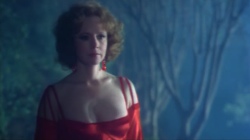
 According to my trusty Leonard Maltin iPhone app, director Curtis Harrington was so disappointed with the television version of his Ruby, he insisted on taking the infamous Alan Smithee credit. Before it was retired, the pseudonym was used by filmmakers who felt their artistic vision had been so catastrophically usurped, they could not allow to have their name attached to a project, lest it negatively affect their reputation and career.
According to my trusty Leonard Maltin iPhone app, director Curtis Harrington was so disappointed with the television version of his Ruby, he insisted on taking the infamous Alan Smithee credit. Before it was retired, the pseudonym was used by filmmakers who felt their artistic vision had been so catastrophically usurped, they could not allow to have their name attached to a project, lest it negatively affect their reputation and career.
But having just sat through the unmolested director’s cut for which he took full credit, I’m having difficulty imagining how much worse that other version could be. I say this because the film I watched is so relentlessly mediocre, it’s hard to figure out how it could ever be edited into an outright Smithee-worthy disaster. As is, Ruby simply doesn’t take enough risks to ever be that bad.
 Pointlessly set in 1951 (a fact easily forgotten given how little effort is made to convincingly convey the period), Ruby is a supernatural gangster revenge thriller with a mute teenage girl thrown into the mix just so the producers could throw Exorcist and Omen references into the trailer. A post-Carrie Piper Laurie looks fabulous as the title character — a washed-up singer/moll who runs a drive-in 16 years after the father of her daughter was gunned down by the other members of his gang — but overplays the part to the precipice of campy embarrassment.
Pointlessly set in 1951 (a fact easily forgotten given how little effort is made to convincingly convey the period), Ruby is a supernatural gangster revenge thriller with a mute teenage girl thrown into the mix just so the producers could throw Exorcist and Omen references into the trailer. A post-Carrie Piper Laurie looks fabulous as the title character — a washed-up singer/moll who runs a drive-in 16 years after the father of her daughter was gunned down by the other members of his gang — but overplays the part to the precipice of campy embarrassment.
Unfortunately, there isn’t enough of her performance to turn the film into a so-bad-it’s-good classic à la Mommie Dearest. Instead, Ruby is the least satisfying kind of bad film there is: a dull, unimaginative one. Which is something of which even Alan Smithee would be ashamed. —Allan Mott
